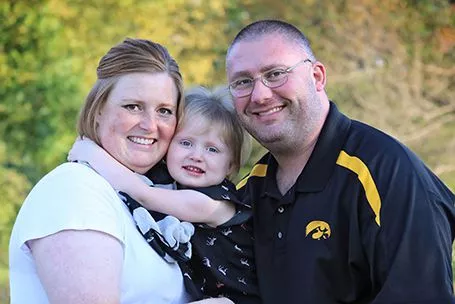Chloe's story

Kate and Cory Simpson of Fort Dodge, Iowa, were expecting their first child together in spring 2012. At Kate’s 36-week checkup, her obstetrician noted that the baby’s heart rate had spiked briefly.
At Kate’s next appointment the following week, the baby’s heart rate raced to 180 beats per minute. The care team worked quickly to move Kate from the clinic to the facility’s birthing center. When the baby’s heart rate reached 220, the decision was made to deliver by C-section.
Chloe Simpson was born at 6:01 p.m. She looked fine—good color, no signs of distress. Best of all, her heart rhythm was normal.
But by 10 p.m., Chloe’s heart rate started climbing again. She was flown in the middle of the night to Blank Children’s Hospital in Des Moines. When Chloe arrived, her rate was approaching 280 beats per minute—well above the “normal” rate range of 100 to 200 beats per minute for a newborn like Chloe—and she was showing signs of distress. Her Des Moines medical team tried defibrillation six different times to reset the speeding heart rhythm.
“They vented her and tried everything until they finally stabilized her,” Kate says.
The Simpsons learned that Chloe had atrial ectopic tachycardia, a specific type of arrhythmia involving the atrium, or upper two chambers of the heart.
Normal electrical conduction in the heart begins with a “spark” of electricity in the sinus node, located in the upper right atrium. The signal moves from the sinus node through the atrium and is transmitted to the AV node to the ventricles. As the electricity moves through the ventricles, the heart muscle contracts. Chloe’s problem was an “extra” spark that beat too quickly, causing her erratic heart rhythm.
The Des Moines pediatric cardiologists, in consultation with the UI pediatric EP team, tried different medication combinations to keep Chloe stabilized and help her grow. The newborn looked healthy, but her heart output tests showed otherwise. After three weeks, when it was clear that medications would not correct the problem, Chloe was transported by ambulance to UI Stead Family Children’s Hospital.
Dr. Ian Law’s plan was to first monitor Chloe while adjusting her medications, giving her more time to grow. Over time, however, her heart function began declining to a dangerous level.
At 5 ½ weeks old, Chloe became the youngest and smallest baby in the world to undergo a catheter ablation with 3-D mapping at UI Stead Family Children’s Hospital. She weighed just over 7 pounds. Using 3-D mapping technology rather than X-rays, the team was able to pinpoint the location of the abnormal area causing the elevated heart rate. With delicate precision, radiofrequency energy was applied at the tip of a catheter to “burn” the tiny bit of tissue until it no longer produced the hyperactive electrical spark.
Within seconds, Chloe’s heart returned to a normal rhythm. A few days later, her heart function was back to normal, and she was cleared to go home.
The Simpsons received another scare about five weeks later when Chloe’s heart rate spiked again. Tests revealed an entirely different, yet relatively common, tachycardia, which may have been blocked (and thus, undetected) by medications administered during Chloe’s initial hospitalization.
Fortunately, this time medications worked to control the tachycardia. Chloe continued drug therapy for nearly a year until she literally outgrew the disruptive signal. Since August 2013, it’s been smooth sailing and no meds for the toddler.
“We no longer need to listen to her heart every day,” Kate says, “but I still check it a lot. I probably always will.”